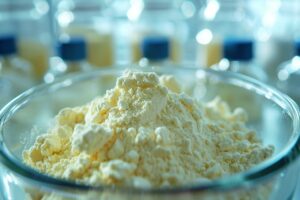4-Difluoromethoxy-3-hydroxybenzaldehyde (CAS NO. 151103-08-1) serves as a crucial chemical intermediate in various organic synthesis processes. This compound, with the molecular formula C8H6F2O3 and a molecular weight of 188.13, plays a vital role in constructing complex molecules for pharmaceuticals and agrochemicals. Its reactivity makes it indispensable for synthesizing advanced pharmaceutical compounds, including those used to treat chronic obstructive pulmonary disease (COPD). The significance of 4-Difluoromethoxy-3-hydroxybenzaldehyde in pharmaceutical research underscores its importance in modern medicinal chemistry.
Applications of 4-Difluoromethoxy-3-hydroxybenzaldehyde

Use in the synthesis of phosphodiesterase-4 (PDE4) inhibitors
Importance in pharmaceutical research
4-Difluoromethoxy-3-hydroxybenzaldehyde plays a pivotal role in the synthesis of phosphodiesterase-4 (PDE4) inhibitors. PDE4 inhibitors serve as therapeutic agents for treating inflammatory diseases like chronic obstructive pulmonary disease (COPD) and psoriasis. The interaction between 4-Difluoromethoxy-3-hydroxybenzaldehyde and the PDE4 enzyme leads to the inhibition of its function, which reduces inflammation. This compound's action, efficacy, and stability under various environmental factors make it invaluable in pharmaceutical research.
Examples of PDE4 inhibitors
Several well-known PDE4 inhibitors utilize 4-Difluoromethoxy-3-hydroxybenzaldehyde in their synthesis. Roflumilast, a drug used to manage COPD, exemplifies such an inhibitor. Another example includes apremilast, which treats psoriasis and psoriatic arthritis. These drugs highlight the compound's critical role in developing effective treatments for inflammatory conditions.
Role in proteomics research
Benefits for proteomics studies
4-Difluoromethoxy-3-hydroxybenzaldehyde also finds applications in proteomics research. Proteomics involves studying the structure and function of proteins on a large scale. This compound aids in labeling and identifying proteins, which enhances the understanding of protein interactions and functions. Researchers benefit from using 4-Difluoromethoxy-3-hydroxybenzaldehyde due to its high reactivity and specificity, which improves the accuracy of proteomic analyses.
Case studies or examples
Several case studies demonstrate the utility of 4-Difluoromethoxy-3-hydroxybenzaldehyde in proteomics. For instance, researchers have used this compound to study protein-protein interactions in cancer cells. The findings from these studies have provided insights into the molecular mechanisms driving cancer progression. Another example includes its use in identifying biomarkers for neurodegenerative diseases, which has facilitated the development of diagnostic tools and potential treatments.
Where and How to Purchase 4-Difluoromethoxy-3-hydroxybenzaldehyde

Comparison of Suppliers
Product purities
Different suppliers offer various purity levels for 4-Difluoromethoxy-3-hydroxybenzaldehyde. VWR provides a purity of ≥95%. Chemscene offers a higher purity level of >98.0%. Neurology Research Chemicals and Analytical Standards supply reference standards with high purity. Synthonix also sells this compound, ensuring quality for research purposes.
Quantities available
Suppliers provide 4-Difluoromethoxy-3-hydroxybenzaldehyde in multiple quantities. Santa Cruz offers different sizes, including 5g and 100g. Synthonix sells smaller amounts, such as 250mg. Larger quantities can be sourced from other distributors, catering to various research needs.
Prices
Prices for 4-Difluoromethoxy-3-hydroxybenzaldehyde vary among suppliers. Synthonix lists a price of $18 for 250mg. Another supplier offers 5g for $81.05. Prices fluctuate based on quantity and purity levels. Researchers should compare prices to find the best deal.
As a manufacturing for 4-Difluoromethoxy-3-hydroxybenzaldehyde, it has already been commercialized, with normal inventory measured in tons. Our production capacity can definitely meet your needs, and the pricing will be determined based on the volume of your order.
Practical Tips for Buying
Checking for purity levels
Researchers must verify the purity levels of 4-Difluoromethoxy-3-hydroxybenzaldehyde before purchasing. High purity ensures reliable results in experiments. Suppliers usually provide certificates of analysis. These documents confirm the compound's purity.
Considering the reputation of the supplier
The reputation of the supplier plays a crucial role in purchasing decisions. Established suppliers like VWR and Chemscene have a track record of providing high-quality chemicals. Researchers should opt for reputable suppliers to avoid substandard products.
Reading customer reviews
Customer reviews offer valuable insights into the quality of 4-Difluoromethoxy-3-hydroxybenzaldehyde. Reviews highlight the experiences of other researchers. Positive feedback indicates reliable suppliers. Negative reviews may signal potential issues with the product or service.
Additional Considerations
Shipping and Handling
Safety measures
Shipping 4-Difluoromethoxy-3-hydroxybenzaldehyde requires strict safety measures. Proper packaging prevents contamination and ensures stability. Suppliers must use chemical-resistant containers. Labels should indicate hazardous materials. Protective gear, such as gloves and goggles, is essential for handling.
Delivery times
Delivery times for 4-Difluoromethoxy-3-hydroxybenzaldehyde vary by supplier. Some suppliers offer expedited shipping options. Researchers should consider lead times when planning experiments. Delays can impact project timelines. Tracking information helps monitor shipment status.
Legal and Regulatory Aspects
Compliance with local regulations
Purchasing 4-Difluoromethoxy-3-hydroxybenzaldehyde involves compliance with local regulations. Different regions have specific guidelines for chemical procurement. Researchers must verify that suppliers adhere to these regulations. Non-compliance can result in legal issues and fines.
Import/export restrictions
Importing or exporting 4-Difluoromethoxy-3-hydroxybenzaldehyde may face restrictions. Countries impose regulations to control the movement of chemicals. Researchers need to check import/export laws before purchasing. Failure to comply can lead to confiscation or penalties. Documentation, such as permits and licenses, may be required.
4-Difluoromethoxy-3-hydroxybenzaldehyde serves as a vital chemical intermediate in pharmaceuticals and agrochemicals. This compound plays a crucial role in synthesizing PDE4 inhibitors and advancing proteomics research. Researchers can purchase this compound from various suppliers, ensuring high purity and quality. Safety measures and compliance with local regulations remain essential during procurement.
For further reading, consider the following resources:
- SpringerLink: Behavior of Fluorinated Compounds
- TCI Chemicals: Storage Recommendations







